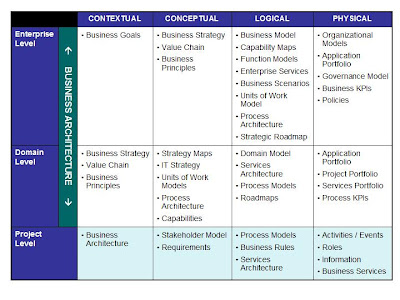I believe that there are at least 3 breeds who now claim to be Business Architects.
- The Enterprise Business Architect
- The Domain Business Architect
- The Project Business Architect a.k.a the Business Analyst
So, let's make it clear - Business Architecture is not something you do at the Project level. Forrester agrees that Business Architects are not Business Analysts. In 'The Up-And-Coming Business Architect' by Jeff Scott and Katie Smillie, they say:
"Forrester believes that these roles are quite distinct, with business architects designing and analyzing the "what" of the business at a higher, more strategic, and often enterprisewide level, while business analysts typically contribute to the "how" of business operations, processes, and projects."
Also, if we look at how the Business Architecture Community defines Business Architecture, as:
"A disciplined approach to creating and maintaining a set of business-owned information assets that serve as a blueprint for the planning and execution of strategy.
- First and foremost, Business Architecture is developed by the business for the business.
- Business Architecture provides a common, enterprise-level business language and framework for documenting how the business is structured."
It is clear from this definition that Business Architecture is about the planning and execution of strategy, which is usually done at the Enterprise and Domain or Line-Of-Business levels, and not at the Project level.
So, lets now look at this in more detail and try to understand what artefacts you may find in a Business Architecture at the different levels. In the following framework I've listed artefacts from an Architectural perspective, i.e. Contextual provides the 'Why?', Conceptual states the 'What?', Logical says 'How?', and Physical says 'With What?'






